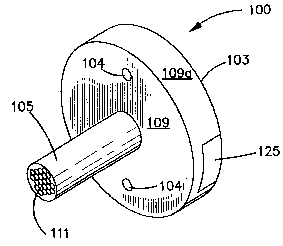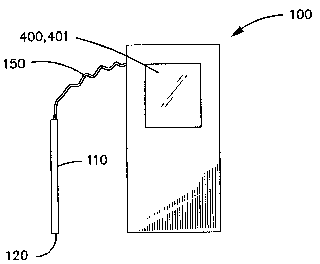|
|
|
| Home | Humor | Technology | About |

Choose YOUR language and Translate this page!
By PDQ Campbell
Termites have evolved in such a way that stealth is largely on their side as a means of survival. They are commonly difficult to detect, especially in their early stages of infestation, even by a trained professional under some circumstances. And detection is absolutely paramount both for the safety of the structure, and for proper accurate delivery of control pesticides.
Technology has made inroads into new detection devices, and they have ranged from sophisticated devices such as listening apparatus to moisture meters, and even as far as trained dogs. But until now an efficient, effective, reliable and economical detection means was not available.
Inventors David Martin of Metairie, La., and Eric Tober of Alexandria, Va., have developed a new "Termite Detection Apparatus" that actually relies on the gasses termites emit for their detection. The system comprises a sensor and associated microprocessor that detect the presence of gases emitted by termites. The processor relays a signal to an appropriate output device to alert a user that the system has detected the presence of termites. Now assigned to Relative Solutions Corporation in Metairie, La., the invention received U.S. Patent no. 6,150,944 on November 21, 2000.
 Entomologists have discovered that termites, simply in the course
of carrying out their biological life cycle, emit a number of specific gasses
not typically found in the open atmosphere. These include naphthalene,
delta-3-carene, 2,3,7-trimethyloctane, 2,6,10-trimethyldodecane, elemene,
alpha-longipene, aristolene, calarene, beta-guaiene,
N-(1-methylhexylidene)-methylamine, 2,6,10,14-tetramethylpentadecane,
alpha-muurolene, and fenchone. The inventors have developed their detector with
a sensor specifically sensitive to only this group of gasses or combinations of
them.
Entomologists have discovered that termites, simply in the course
of carrying out their biological life cycle, emit a number of specific gasses
not typically found in the open atmosphere. These include naphthalene,
delta-3-carene, 2,3,7-trimethyloctane, 2,6,10-trimethyldodecane, elemene,
alpha-longipene, aristolene, calarene, beta-guaiene,
N-(1-methylhexylidene)-methylamine, 2,6,10,14-tetramethylpentadecane,
alpha-muurolene, and fenchone. The inventors have developed their detector with
a sensor specifically sensitive to only this group of gasses or combinations of
them.
 The
inventors have arranged their device in two different forms. The first style
(shown above) appears to be a permanent or semi-permanent detector that is
installed in a structure and fastened in place. The "wand" is inserted into the
wall, and the sensor/detector is mounted on the face of the wall. This is
tantamount to the pest control equivalent of a smoke detector. The second
style, shown here, is a mobile unit specifically designed and intended for pest
control inspectors. In this style of device the gas sensors are installed in
the end of a long wand at the end of a cable. The instrument body contains the
processor and the output device, which is preferably a LCD display. This allows
the inspector to insert the wand and make an analysis on areas that would
otherwise be inaccessible with substantial invasive surgery to the
structure.
The
inventors have arranged their device in two different forms. The first style
(shown above) appears to be a permanent or semi-permanent detector that is
installed in a structure and fastened in place. The "wand" is inserted into the
wall, and the sensor/detector is mounted on the face of the wall. This is
tantamount to the pest control equivalent of a smoke detector. The second
style, shown here, is a mobile unit specifically designed and intended for pest
control inspectors. In this style of device the gas sensors are installed in
the end of a long wand at the end of a cable. The instrument body contains the
processor and the output device, which is preferably a LCD display. This allows
the inspector to insert the wand and make an analysis on areas that would
otherwise be inaccessible with substantial invasive surgery to the
structure.
How the processor utilizes the signals from the sensor and makes a determination about the specific gasses present is actually a fairly sophisticated process within the device. The patent outlines a number of different methods that can be used. On the simplest end of the software spectrum is perhaps use of a commercial software package called Data Acquisition and Analysis (DA2) Software, available from Pondscum, Inc. of North Aurora, Ill. As the patent goes on however, it starts to list other candidates incorporated into the brain of the device such as a "neural net module" incorporating "Additional methodology, available under license from Argonne National Laboratories in connection with a license of suitable sensors . . .." The neural net module can be trained to recognize particular gasses.
Fortunately all of this high-end technology is ostensibly already incorporated into the termite detector by the manufacturer so the pest inspector doesn't have to be a computer scientist to use the equipment. Under the auspices of the patent at least, the detector can incorporate either the LCD display mentioned earlier, a computer read-out screen, simple indicators lights and/or audible signals. Standard dry-cell batteries, just like those used in any small radio, power the entire device. Admittedly there is no reason to believe that it couldn't just as well utilize a more complex rechargeable battery like the type typically used on a mobile telephone without deviating from the intent of the patent.
Commercial availability of this new detection device seems to still be a ways off, as Relative Solutions Corporation is not even yet listed in the Metairie, La. phone directory. Still the concept is important in that what would have sounded like science fiction only a few years ago now makes "scanning for life-forms" an imminent reality. It is not unreasonable to extrapolate that as biologists and entomologists define more characteristics of living organisms that engineers and inventors will develop new equipment for detecting those same elements. Does that mean that inspectors will soon be able to scan for specific DNA to detect pests? Perhaps, but only when the supporting technology makes it financially feasible for manufacturers.
Paul Campbell is a columnist and author in central Florida. His column Homeworld appears here every week. Feel free to write to Paul at techpubs@ix.netcom.com or visit him on the web at http://techpubs.home.netcom.com.
| Industrial and Engineering Books by Paul Campbell | |||
| Handbook of Mechanical Fasteners | Basic Fixture Design | Plastic Component Design | Introduction to Measuration and Calibration |